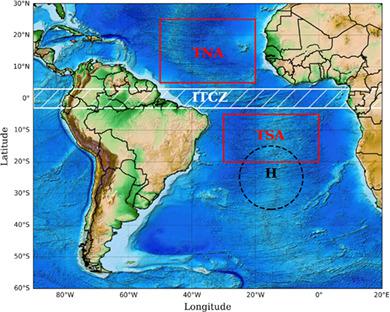当前位置:
X-MOL 学术
›
Int. J. Climatol.
›
论文详情
Our official English website, www.x-mol.net, welcomes your feedback! (Note: you will need to create a separate account there.)
Analysis of CMIP 5 simulations of key climate indices associated with the South America monsoon system
International Journal of Climatology ( IF 3.9 ) Pub Date : 2020-05-03 , DOI: 10.1002/joc.6627 Vanesa Londoño Arteaga 1 , Carlos Henrique Ribeiro Lima 2
International Journal of Climatology ( IF 3.9 ) Pub Date : 2020-05-03 , DOI: 10.1002/joc.6627 Vanesa Londoño Arteaga 1 , Carlos Henrique Ribeiro Lima 2
Affiliation

|
Assessing the regional and local impacts of climate changes on rainfall and streamflow patterns is often challenging, as most results tend to be very dispersed and inconsistent across models. We offer a complementary alternative for climate change impact studies by focusing primarily on climate indices. In particular, we analyse the historical and future variability of key climate indices associated with the South America Monsoon System (SAMS) as simulated by Coupled Model Intercomparison Project—Phase 5 (CMIP5) models. We use climate indices related to the tropical Atlantic interhemispheric surface temperature gradient, associated with the meridional position of the Intertropical Convergence Zone (ITCZ), as well as the land‐ocean temperature contrast in the tropical Atlantic‐South America region, and the intensity and position of the South Atlantic Subtropical High (SASH). We selected 14 CMIP5 models to estimate climate indices for the retrospective period (1980–2005) and future period (2006–2099), the latter under the RCP 4.5 and RCP 8.5 scenarios. For comparison purposes during the retrospective period, the indices were also calculated using data from the Era‐Interim reanalysis. The seasonal behaviour of the Era‐Interim based indices is well reproduced by CMIP5 models, although the magnitude is significantly higher. For the future period, most models under both scenarios showed a consistent and asymmetrical intensification of the dipole index, suggesting, in a future climate, a potential wider displacement of the ITCZ during its seasonal cycle. As for the land‐ocean contrast index, the CMIP5 simulations indicated consistent increase in the magnitude for the positive phase (land warmer than ocean) and a decrease for the negative phase (land colder than ocean). Finally, CMIP5 models consistently predict a strengthening and southward displacement of the SASH centre. To the best of our knowledge, this is the first study to reveal future changes in climate indices associated with the SAMS that shows relevant coherences across models and scenarios.
中文翻译:

与南美季风系统相关的关键气候指数的CMIP 5模拟分析
评估气候变化对降雨和水流模式的区域和地方影响通常是具有挑战性的,因为大多数结果往往在模型之间非常分散且不一致。通过主要关注气候指数,我们为气候变化影响研究提供了一种补充方案。特别是,我们通过耦合模型比较项目-阶段5(CMIP5)模型对与南美季风系统(SAMS)相关的关键气候指数的历史和未来变化进行了分析。我们使用与热带大西洋半球表面温度梯度有关的气候指数,并与热带辐合带(ITCZ)的子午线位置相关,以及热带大西洋-南美地区的陆-海温度对比,以及南大西洋副热带高压(SASH)的强度和位置。我们选择了14个CMIP5模型来估计追溯期(1980-2005年)和未来期(2006-2099年)的气候指数,后者在RCP 4.5和RCP 8.5情景下。为了在回顾期间进行比较,还使用Era-Interim重新分析的数据计算了指数。CMIP5模型很好地再现了基于时代中期指数的季节性行为,尽管幅度明显更高。对于未来的时期,两种情况下的大多数模型都显示出偶极子指数的一致且不对称的增强,这表明在未来的气候中,ITCZ在其季节性周期中可能会出现更大的位移。至于陆海对比指数,CMIP5模拟表明,正相(陆地温度比海洋高)的幅度持续增加,而负相(陆地温度比海洋冷)的幅度持续减小。最后,CMIP5模型始终预测SASH中心的加强和向南位移。据我们所知,这是第一项揭示与SAMS相关的气候指数未来变化的研究,该变化显示了各个模型和场景之间的相关一致性。
更新日期:2020-05-03
中文翻译:

与南美季风系统相关的关键气候指数的CMIP 5模拟分析
评估气候变化对降雨和水流模式的区域和地方影响通常是具有挑战性的,因为大多数结果往往在模型之间非常分散且不一致。通过主要关注气候指数,我们为气候变化影响研究提供了一种补充方案。特别是,我们通过耦合模型比较项目-阶段5(CMIP5)模型对与南美季风系统(SAMS)相关的关键气候指数的历史和未来变化进行了分析。我们使用与热带大西洋半球表面温度梯度有关的气候指数,并与热带辐合带(ITCZ)的子午线位置相关,以及热带大西洋-南美地区的陆-海温度对比,以及南大西洋副热带高压(SASH)的强度和位置。我们选择了14个CMIP5模型来估计追溯期(1980-2005年)和未来期(2006-2099年)的气候指数,后者在RCP 4.5和RCP 8.5情景下。为了在回顾期间进行比较,还使用Era-Interim重新分析的数据计算了指数。CMIP5模型很好地再现了基于时代中期指数的季节性行为,尽管幅度明显更高。对于未来的时期,两种情况下的大多数模型都显示出偶极子指数的一致且不对称的增强,这表明在未来的气候中,ITCZ在其季节性周期中可能会出现更大的位移。至于陆海对比指数,CMIP5模拟表明,正相(陆地温度比海洋高)的幅度持续增加,而负相(陆地温度比海洋冷)的幅度持续减小。最后,CMIP5模型始终预测SASH中心的加强和向南位移。据我们所知,这是第一项揭示与SAMS相关的气候指数未来变化的研究,该变化显示了各个模型和场景之间的相关一致性。



























 京公网安备 11010802027423号
京公网安备 11010802027423号